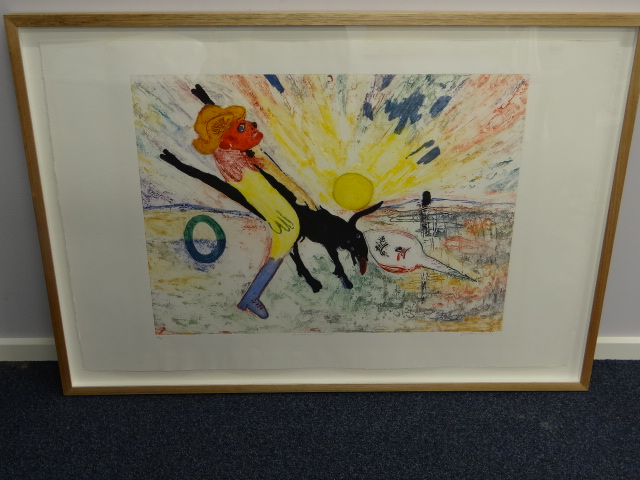Arthur Boyd
ARTHUR BOYD (Australian, 1920-1999)
Australian Scapegoat 1990 collagraph Edition: #/25 62 x 84cm (image) #dimensions (framed) Acquired 2015 #Inventory/Catalogue No. 113509 |  |
Biography:
Arthur Boyd is regarded as one of Australia’s most celebrated artists, whose six-decade long career has encompassed a multi-genre practice of painting, printmaking and ceramics.
With a focus on humanist concerns, Boyd aimed to convey an inner emotional vision through his work, rather than simply evoking the external world. Embedded with lyrical and emotive allegories on universal themes of love, loss and shame, and invariably employing the vast and expansive Australian landscape as backdrop to these concepts, Boyd’s works sought to make sense of an ever-changing world.
Boyd’s formal education included night classes at the National Gallery School in Melbourne, alongside tutelage from his artist parents, Merric and Doris Boyd, in addition to time spent living with his grandfather, Arthur Merric Boyd, also an artist, on the Mornington Peninsula.[1]
Boyd’s experiences of WWII (as part of the Cartographic Unit)[2], provided much of his subject matter for the works produced during the 1940s, and may well have prompted his interest in the Bible on his return, which engendered another material source for his works of the later 1940s.
A decade later, Boyd’s travels throughout central Australia initiated a new and major body of work, the “Love, marriage and death of a half-caste”, a series of lavish expressionistic paintings depicting a fictional story about the death of an aboriginal stockman and his half-caste bride.[3]
In 1959, Boyd joined a group of painters known as the ‘Antipodeans’ and championed by art historian Bernard Smith[4], which saw the artists exhibit at Whitechapel Gallery in London in the same year. Remaining in London, Boyd’s subject matter continued to focus on the human condition, albeit a stronger articulation of Australia bush settings.[5]
Boyd and his family returned to Australia in 1971, settling at ‘Bundanon’, a property situated on the Shoalhaven River in New South Wales. It was these environs and this landscape, which proved a rich source of inspiration for much of Boyd’s final works. In 1993, Arthur and his wife Yvonne gifted their property Bundanon, comprising of 1,100 hectares, to the Australian people.[6]
Artwork:
During the 1980s Boyd embarked on a series of paintings known as “Australian Scapegoat”, the subject of which explores constructions of Australian military identity. The subject artwork, a print derivative of the series, is a particularly graphic and sexual, depiction of an Australian digger in a slouch hat having intercourse with a goat.
Bibliography:
Murray Cree, L., & Drury, N., Australian Painting Now, Craftsman House, Sydney, 2000
Sayers, Andrew, Australian Art, Oxford University Press, 2001
Hughes, Robert, The Art of Australia, Penguin Books, 1970
Hoff, U., The Art of Arthur Boyd, Andre Deutsch, London, 1986
Further reading:
Pearce, B., Arthur Boyd, A Retrospective, The Beagle Press, Sydney, 1994
Haese, Richard, Rebels and Precursors, Penguin Books, 1988
Visit:
The NGA has an extensive collection of works by Arthur Boyd.
Visit the newly opened Bundanon, an arts & cultural centre and extraordinary philanthropic gift by the Boyd family.
[1] Murray Cree, L., & Drury, N., Australian Painting Now, Craftsman House, Sydney, 2000, p. 60
[2] Sayers, Andrew, Australian Art, Oxford University Press, 2001, p. 162
[3] Hughes, Robert, The Art of Australia, Penguin Books, 1970, p.232
[4] Ibid, p. 246
[5] Murray Cree, L., & Drury, N., ibid., p. 60
[6] Op cit
Other related works:
Arthur Boyd, The Princess of Sandakhan
Arthur Boyd, The Poet
Arthur Boyd, The Hunter
Arthur Boyd, Pulpit Rock

